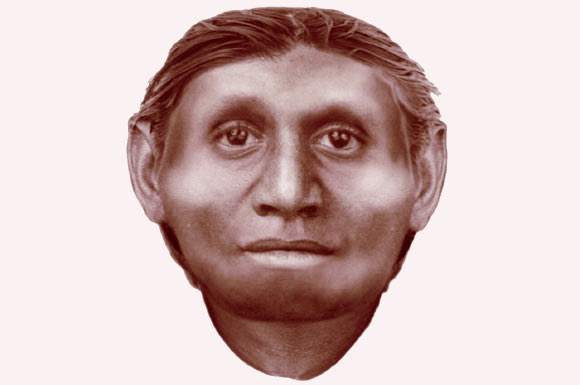According to a multinational team of scientists, Homo floresiensis — a primitive hominin species discovered in the Late Pleistocene sediments at Liang Bua, Flores, Indonesia — may have met their demise earlier than once believed.

Facial approximation of Homo floresiensis. Image credit: Susan Hayes / Australian Archaeological Association.
The team, headed by Dr. Thomas Sutikna from the University of Wollongong in Australia and the Pusat Penelitian Arkeologi Nasional in Indonesia, challenges reports that Homo floresiensis co-existed with anatomically modern humans for tens of thousands of years.
The scientists found problems with prior dating efforts at the cave site of Liang Bua.
They measured the amount of uranium and thorium inside Homo floresiensis fossils, and found that the youngest age for this species is around 50,000 years ago, not between 13,000 and 11,000 years as initially claimed.
“In fact, Homo floresiensis seems to have disappeared soon after our species reached Flores, suggesting it was us who drove them to extinction,” said team member Dr. Maxime Aubert, of Griffith University and the University of Wollongong.
“The science is unequivocal. The youngest skeletal remains of Homo floresiensis occur at 60,000 years ago but evidence for their simple stone tools continues until 50,000 years ago. After this there are no more traces of these humans.”
It was thought that a population of Homo floresiensis lived on Flores until about 12,000 years ago.
But the site of Liang Bua is large and complex and the original excavators dug only a tiny portion of it.
Years of further excavation has led to a much clearer understanding of the order of archaeological layers.
It is now evident that when the original team collected samples for dating the main layer containing Homo floresiensis bones they mistakenly took them from an overlying layer that is similar in composition, but far younger.
“This problem has now been resolved and the newly published dates provide a more reliable estimate of the antiquity of this species,” Dr. Aubert said.
But the mystery of what happened to these creatures remains.
“Homo floresiensis are likely to have inhabited other Flores caves which may yield more recent signs of their existence,” said team member Dr. Adam Brumm, also from Griffith University and the University of Wollongong.
“Whether they survived after 50,000 years ago – potentially encountering modern humans on Flores or other hominins dispersing through Southeast Asia, such as Denisovans – is an open question,” the scientists said.
The results were published online today in the journal Nature.
_____
Thomas Sutikna et al. Revised stratigraphy and chronology for Homo floresiensis at Liang Bua in Indonesia. Nature, published online March 30, 2016; doi: 10.1038/nature17179







